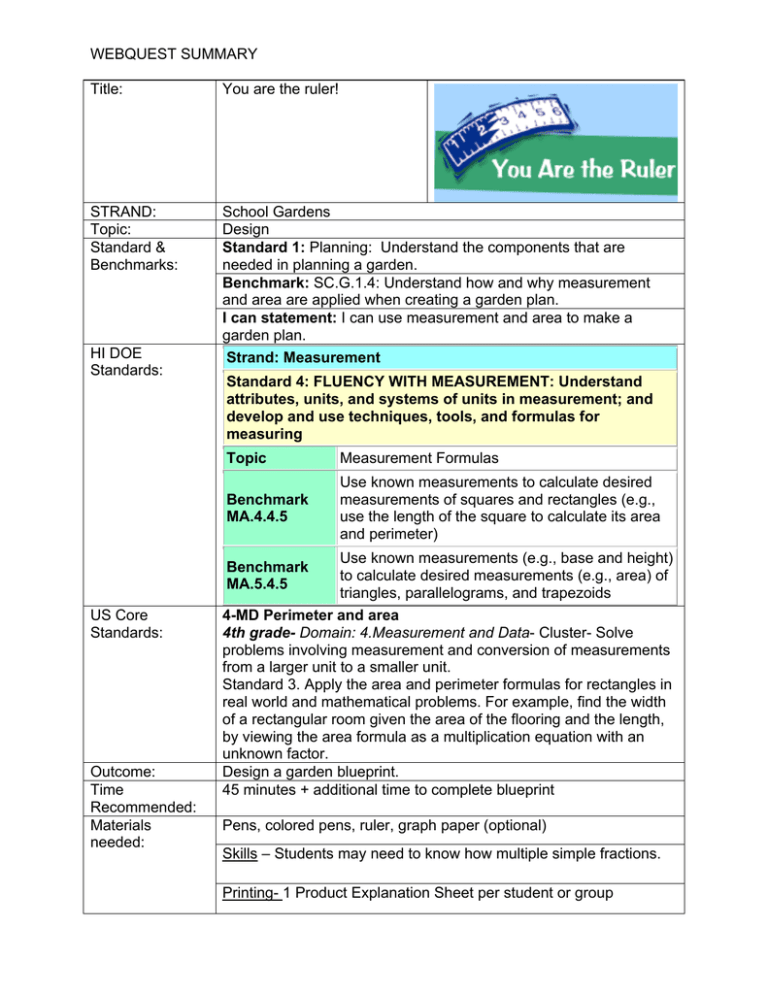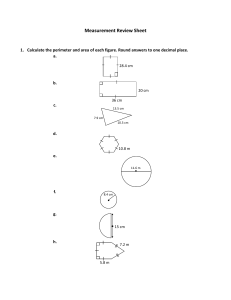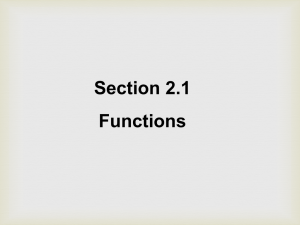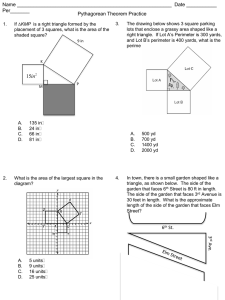WEBQUEST SUMMARY Title: You are the ruler!
advertisement

WEBQUEST SUMMARY Title: You are the ruler! STRAND: Topic: Standard & Benchmarks: School Gardens Design Standard 1: Planning: Understand the components that are needed in planning a garden. Benchmark: SC.G.1.4: Understand how and why measurement and area are applied when creating a garden plan. I can statement: I can use measurement and area to make a garden plan. Strand: Measurement HI DOE Standards: Standard 4: FLUENCY WITH MEASUREMENT: Understand attributes, units, and systems of units in measurement; and develop and use techniques, tools, and formulas for measuring Topic Measurement Formulas Benchmark MA.4.4.5 Use known measurements to calculate desired measurements of squares and rectangles (e.g., use the length of the square to calculate its area and perimeter) Use known measurements (e.g., base and height) to calculate desired measurements (e.g., area) of triangles, parallelograms, and trapezoids 4-MD Perimeter and area 4th grade- Domain: 4.Measurement and Data- Cluster- Solve problems involving measurement and conversion of measurements from a larger unit to a smaller unit. Standard 3. Apply the area and perimeter formulas for rectangles in real world and mathematical problems. For example, find the width of a rectangular room given the area of the flooring and the length, by viewing the area formula as a multiplication equation with an unknown factor. Design a garden blueprint. 45 minutes + additional time to complete blueprint Benchmark MA.5.4.5 US Core Standards: Outcome: Time Recommended: Materials needed: Pens, colored pens, ruler, graph paper (optional) Skills – Students may need to know how multiple simple fractions. Printing- 1 Product Explanation Sheet per student or group Equipment (beside computer) – calculator (optional), PowerPoint or other presentation program (optional) Options: Provide students with dimensions of a possible gardening space at their school. Display their blueprints in the classroom and work with students to build a garden. Students may complete the blueprint as homework after they have taken notes on the plant information. The product can be done on the computer using a presentation program, such as PowerPoint. Students may work in pairs to complete the product. Product Differentiation: Students needing extra support can complete their blueprints on graph paper and check their area and perimeter calculations by counting the squares. Challenge students to design their garden to be able to fit the most plants with the plants spaced out sufficiently. Encourage student to include any shape that they can calculate the area and perimeter of on their garden blueprint. Triangles, parallelograms, circles etc. could both add to the design and math component of the WQ. This would satisfy benchmarks in 5th and up grade levels. Students might also include the depth of the planting space and calculate the volume. You might ask them how much soil they would need to fill the container 3/4th of the way.






